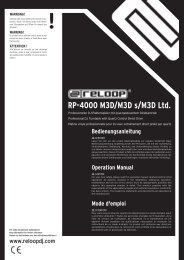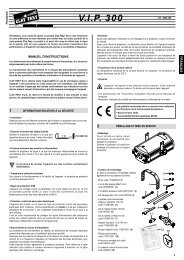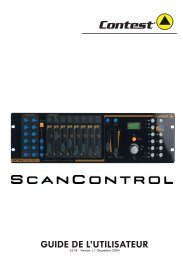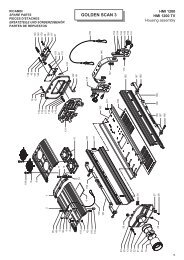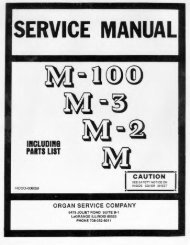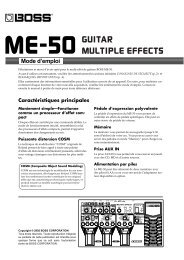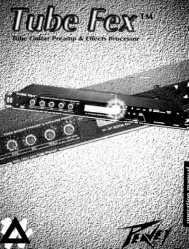OSC B KBD and FILT KBD switches are for keyboard tracking in UNISON mode. UNISON CV is^.In UNISON (monophonic) mode a UNISON CV derived from the lowest note played on the keyboardbecomes the main pitch controi for allvoices through the Common Analog circuitry. The five GATEsoccur simultaneously, but the envelope generators only re-trigger ifno keys are held.The microcomputer system itself consists of the microprocessor or CPU, memory (MEM), andinput/output (I/O) Interface. The CPU executes the program permanently residing in the read-onlymemory (EPROM). This program determines how the various input devices— keyboards, switches, andknobs—are "read", and how "data" generated by them is"processed" to control the synthesizer. TheScratchpad RAM is the CPU's work area. It holds data representing the current status of the keyboardand all controls. Control status depends on the operational mode. In MANUAL mode the control datacorresponds to the current settings of the black, programmable knobs and switches. If desired this datacan be recorded from Scratchpad to the Non-Volatile Memory (NV RAM). Then, in PRESET mode,selecting recorded programs moves them from NV to Scratchpad, reprogramming the synthesizer forthat sound. The EDIT feature allows one to alter individual control settings inthen be recorded to supplement or replace the original program inNV RAM.Scratchpad, which canThe remainder of this section discusses the <strong>Prophet</strong>'s actual analog and microcomputer circuitry. Eachsub-circuit is described functionally in relation to its block diagram. Principal !Cs and any uncommondesigns are explained. However the function of common linear, TTL, and MOS ICs isnot coveredbecause anyone contemplating technical work on the <strong>Prophet</strong> must already be familiar with, forexample, combinational logic and op amp circuits.2-3 ANALOG SYNTHESIZER DESCRIPTIONThe definitions of the various CV and switch commands in the analog synthesizer must be clear beforethe Voice and Common Analog sub-circuits can be discussed. Referring to Figure 2-4, the CommonAnalog circuitry includes the master summers (MSUMs), Glide, and WHEEL-MOD circuits. The MSUMSproduce five Common Analog output CVs: A SUM, B SUM, PW A SUM, PW B SUM, and FILT SUM CV.These enable simultaneous pitch control and modulation for the voices, as follows.R104 MASTER TUNE (MTUN) and R1PITCH wheel adjust OSC A and B frequency directly—that is,without computer processing—through A SUM CV and B SUM CV. To prevent interference with theTUNE routine (see paragraph 2-13), the switches shown disconnect these controls during the TUNEroutine. In UNISON mode the KBD component of the FREQ CV appears through the UNISON CV. Theprocessed through the Glide circuit which, essentially, delays quick changes in UNISON CV as GLIDECV increases. The OSC B MSUM is similar to OSC A. FILT SUM CV mainly consists of the FILT CTF CV(which follows the FILT CUTOFF KNOB). An external FILT CV IN can be added through the back panel.The VV-MOD signal, switchable to any MSUM consists of pink noise or LFO output as determined by theW-MOD SOURCE MIX CV. CV inversion to the LFO VGA allows the NOISE and LFO levels to move inopposite directions for a single CV. The MOD wheel sets this mixture's output level to selected MSUMs.Besides the Common Analog output CVs there are two types of computer-output CVs which terminateat the voices. First, Patch CVs control all five voices identically. For example, all five Amplifier EnvelopeGenerator attack times will be equal for any patch, so the Amplifier Envelope Generator ATK CV is wiredto the same terminal on allfive AMP ENV GENs. Other Patch CVs include MIX OSC A, P-MOD ENVAMT, and FILT RESONANCE. Second, the Individual CVs determine the frequency of a single VCO orVCF alone. Each voice has two OSC S/H CVs and one FILT S/H CV. These signals contain the polyphonicKBD component of the total FREQ CV applied to these devices. The ten OSC S/H CVs also contain INITFREQ control—actually common to the OSC As or Bs—and the TUNE "biases", which fine-tuneeach VCO.D.22-7IP
'IAll processed CVs originate from the computer at a separate Sample/Hold (S/H). This circuit isdiscussedin paragraph 2-12, but for introduction Figure 2-4, Detail A shows a typical S/H used with VC-devices.Detail B adds a voltage-to-current converter (V-C CONV) required to control the operationaltransconductance amplifiers (OTAs—see paragraph 2-5) used as "VCAs" in all places. Twenty-three S/Hson PCB 3 supply the Common Analog and Patch CVs and fifteen S/Hs on PCB 4 supply the IndividualOSCandFILTCVs.Voice 1 is used for explanatory purposes, below. The five voices are functionally identical. Seeschematics SD431 and SD334.2-4 OSCILLATOR A, B, AND LFOThe <strong>Prophet</strong>'s eleven oscillators—two per voice, plus one LFO—are based on the CEM 3340 integratedVCO. The IC isscaled at IV/octave. This means an overall CV change of exactly IV ideally produces apitch change of exactly one octave. So a CV change of 1/12V (83.3 mV) changes pitch by one semitone.In the voices the basic oscillator range is nine octaves; resulting from 0-5V supplied by the KBD and 0-4Vsupplied by the OSC FREQ knob through the OSC S/H CV (see Figure 2-4). While most CVs in the<strong>Prophet</strong> are quantized by only the most significant seven bits of a fourteen-bit DAC into 128 83.3-mVsteps (128 X 0.0833V = 10.67V), the OSC S/H CVs are quantized by the full fourteen bits into 16,384 651-uVsteps (16,384 x 0.000651 = 10.67). This finer resolution allows the TUNE circuitry to tune the oscillators towithin 1/128 semitone. Italso allows the SCALE MODE feature, where each note can be raised orlowered by up to a semitone. (For further information, see under DAC and TUNE, paragraphs 2-12 and2-13). In UNISON mode the KBD CV is routed through the Glide circuit and the OSC MSUMs.Additional OSC 1A FREQ control is created on Voice 1 itself through the POLY-MOD circuit. TheP-MOD FREQ A switch applies a CV mixed from the P-MOD FILT ENV and P-MOD OSC B AMT VCAsto the OSC 1A CV SUM input. OSC lA's pulse width iscontrolled by two CVs at the OSC A PW SUM.First PW A SUM CV originates in the Common Analog circuitry as the sum of OSC A PW and W-MODPW A (ifON). Second, the P-MOD PW A switch can add a CV mixed from the FILT ENV GEN and/orOSC B. When on, the OSC A SYNC switch tunes OSC A to harmonic frequencies of OSC B or changesOSC A's timbre when the two are not in harmonic relation. This occurs independently of whatever OSCB waveforms are switched on.OSC B is similar to OSC A except that besides being a pitch source it can be a modulation sourcethrough POLY-MOD, and can operate as an LFO with or without KBD control. In the OSC B MSUM, theOSC B LO FREQ switch adds a -7.5V offset through B SUM CV. To provide adequate control range, theINIT FREQ control doubles its range (to 9V) when OSC B LO FREQ is ON.The LFO itself is not controlled by the keyboard, and its pulse width is fixed at 50% (square wave). Itsoutput isa modulation CV effective through the five MSUMs.Details of the 3340 and associated components can be found on its Data Sheet in the Appendix. All 3340outputs are positive-going. But using the LFO and OSC B as a modulation source requires their trianglepeaks travel as far negative as positive for smooth vibrato. On Voice 1, circuitry containing U451-1 (seeSD431) shifts down the dc-level of the triangle to be symmetrical about ground.While creating a symmetrical signal for modulation, the triangle level-shifting poses a slight problem forthe 4016, which isbasically designed to pass only positive voltages. Figure 2-4, Detail C shows the basiccircuit used for switching allbipolar signals in the <strong>Prophet</strong>. Instead of being grounded, the Vss pin isbiased slightly-negative, allowing the switch to pass slightly negative voltages. Diodes at each switchinput protect the switch by clamping negative voltages to not exceed the diode drop, which is also thenegative bias value (0.6V), Where a bipolar voltage (such as P-MOD OSC B with OSC B TRIANGLE on) isbeing switched, the level must be sharply attenuated, where a current (such as allbeing switched, the only voltage developed isop amp node following the switch isa virtual ground.sunriming nodes) isby the 4016's ON resistance (300 ohm, typical) since the2-8
- Page 1 and 2: ^^. ^ ^s .y ^,-j?^ ^^w^-^>&i^^^V^?v
- Page 3 and 4: PROPHET-5 SYNTHESIZERTECHNICAL MANU
- Page 5 and 6: iJTable of ContentsISECTION 1MECHAN
- Page 7 and 8: '1SECTION 1MECHANICAL1-0 GENERALThi
- Page 9 and 10: Raise the top panel assembly to ser
- Page 11 and 12: 1-5 PCB 1/2 CONTROL PANELSOnce PCB
- Page 13 and 14: Figure 1-5KEYBOARD REMOVAL1 -7/1 -8
- Page 15 and 16: TOADDITIONALVCOsTOADDITIONALENV GEN
- Page 17 and 18: 2-2 THE PROPHETThe Prophet is a sub
- Page 19: COMMON ANALOGVOICE(VOiCES e-5 ARE S
- Page 23 and 24: ajMim—2-8 AUDIO OUTPUTAs shown in
- Page 25 and 26: .'2-10 MICROPROCESSOR, MEMORY, AND
- Page 27 and 28: For troubleshooting, it should be e
- Page 29 and 30: 2-12 ADC, DAC, AND CV OUTPUTSThe DA
- Page 31 and 32: iirH- - jMg 1— -^ 'iVMUX, U201-3^
- Page 33 and 34: the same CV and trigger pattern to
- Page 35 and 36: SECTION 3DOCUMENTS3-0 DOCUMENT LIST
- Page 37 and 38: TOP PANEL ASSEMBLY1CHASSiSLAST \NOT
- Page 39 and 40: TB/0i/20f 32 22 30 20 19 25 233 2 I
- Page 41 and 42: TBZOf/^fOtP^2C20ZTBZOI/IOl17FUT ATK
- Page 43 and 44: OA* Y*tMOlooMtt'O o)i:i'^.^^.1 I5-
- Page 45 and 46: —' i+6V+5d^1—+I5V+ SV+ V ff^ U3
- Page 47 and 48: 1+ I5V£/JJiJ-5|T> -TUNEWBOtWfOiAMP
- Page 50 and 51: P40I+I6V(TUNE MUX)P40iP40f3ft wMIK
- Page 52 and 53: + I5VOSCP40i^Q ^ |PMOPFR£QASFINAL
- Page 54 and 55: M+I5VP40/ x|5v301 K|%34^fM0O£WASR4
- Page 56 and 57: IU504ft50647C5042Z00|iFMCTBMtZCT2 1
- Page 58 and 59: Inpreparation for service, set up t
- Page 60 and 61: 4-2 OSCILLATOR B TESTSTEP MODULE CO
- Page 62 and 63: 4-S FILTER TEST.STEP'MODULE CONTROL
- Page 64 and 65: 4-8 POLY-MOD TEST—A.STEP MODULE C
- Page 66 and 67: i4-11 PITCH WHEEL TRIMThis trim rem
- Page 68 and 69: A)I4-16 VCO SCALE TRIMBE SURE RECOR
- Page 70 and 71:
4-19 FILTER ENVELOPE AMOUNT VCA BAL
- Page 72 and 73:
4-21 FINAL VGA BAL1. Switch PRESET
- Page 74 and 75:
115-3 PCB 3BT301 E-040L-\:!Oi 0-U45
- Page 76 and 77:
I ]U374U375U376U377U37SU379U380U381
- Page 78 and 79:
1R419SR4199R4200R4201R4202R4203R420
- Page 80 and 81:
51» IR44S7/488 R-025R44S9 R-009R44
- Page 82 and 83:
kL096 E-066098 E-071100 E-078102 E-
- Page 84 and 85:
IJ310 M-156312 M-157314 M-158316 M-
- Page 86 and 87:
JJ51S R-161520 R--162522 R-163524 R
- Page 88 and 89:
FFFFDBKFETFFFILTFINFINEFOAFREQFSKFT
- Page 90 and 91:
11 IJSECTION 8THEORY8-0 INTRODUCTIO
- Page 92 and 93:
1 1for the 2 to 5-foot range. The c
- Page 94 and 95:
IiSECTION 9PRCX^RAMMING9-0 INTRODUC
- Page 96 and 97:
I3JIJThe Prophet will not accept st
- Page 98 and 99:
ByteByte 23Switch Bit (7)OSC A PULS
- Page 100 and 101:
t J IISECTION 10REVISION 3.1 and 3.
- Page 102 and 103:
I+ I5V+5dI^1-+5V 2'2pF+I6V+5V^^' U3
- Page 104 and 105:
T&=* PANEL ASSE^^mtYSAfKEYBOARD,'r-
- Page 106 and 107:
.^^'»_ u jj'/X H"r,P-*tQ( p5^f -^"
- Page 108 and 109:
4/J«-5[E> -TUNER57a12wzofwiOi^^^^^
- Page 110 and 111:
—T8502J/fRSOBWMfrS/IC5045.iiU502i
- Page 112 and 113:
^ 1 1 ;4 PINFigure II-OFigure11-TM1
- Page 114 and 115:
I 111-2 REVISION 3.0 MEMORY TESTRev
- Page 116 and 117:
Tr1 1-5 WHEEL BALANCE TRIM1. See pa
- Page 118 and 119:
SECTION 13PROPHET-5 REV 3.3 UPDATET
- Page 120 and 121:
iFigure 13-1PCB 3 TOP MODIFICATIONT
- Page 122 and 123:
T 1ttSillniiinMIttltltlltlillll^- ^
- Page 124 and 125:
i/*5-tft/jj4-y,6-C90H202 >7-CS0H5Q3
- Page 126 and 127:
'^'K'..v''
- Page 128 and 129:
tV t IEPROM1000.3.0V.8.0V.8.1V.8.21
- Page 130 and 131:
IJmemory interface1000.3.01000.3.11
- Page 132 and 133:
ittKRAM, non-volatile (NV)1000.3.01
- Page 134:
1voltage-current convertervoice ass






